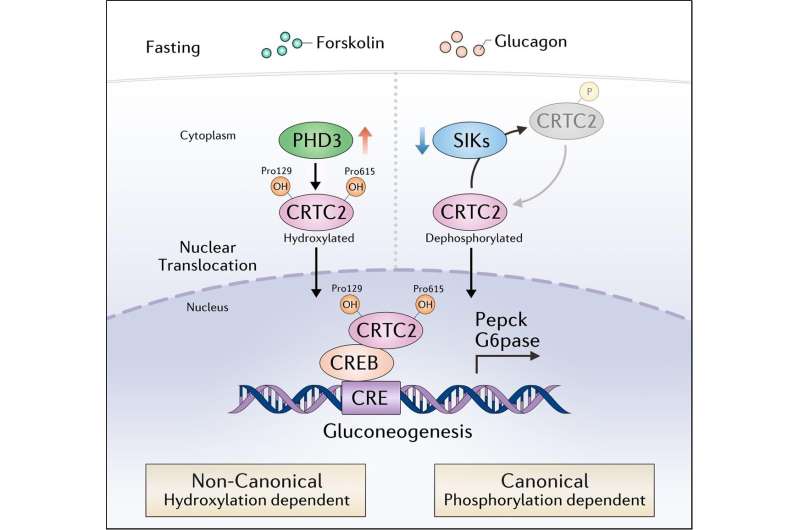This article has been reviewed according to Science X's editorial process and policies. Editors have highlighted the following attributes while ensuring the content's credibility:
fact-checked
peer-reviewed publication
trusted source
proofread
Researchers identify novel mechanism of hepatic gluconeogenesis via PHD3-mediated hydroxylation of CRTC2

A team led by Prof. Li Yu from the Shanghai Institute of Nutrition and Health (SINH) of the Chinese Academy of Sciences (CAS), in collaboration with Prof. Fu Wenguang and Prof. Fang Jing, identified a novel mechanism for the HIF prolyl hydroxylase domain protein 3 (PHD3)-dependent proline hydroxylation of cAMP responsive element binding protein (CREB)-regulated transcriptional coactivator 2 (CRTC2) in the regulation of hepatic gluconeogenesis. This study was published online in PNAS on May 30.
Elevated gluconeogenesis and excessive glucose production in the liver contribute to hyperglycemia and type 2 diabetes. Prolyl hydroxylase (PHD)-mediated protein hydroxylation is involved in the regulation of cellular adaptation to hypoxia. However, whether it is regulated by nutritional or hormonal signals and modulates hepatic gluconeogenesis remains largely unknown.
This study demonstrated that PHD3 acts as a novel regulator in regulating hepatic gluconeogenesis and glucose homeostasis, and that protein levels of PHD3 are potently induced in the liver and hepatocyte in response to fasting signals.
To investigate whether PHD3 and its hydroxylase activity is required for hepatic glucose metabolism, liver-specific knockout of PHD3 or prolyl hydroxylase-deficient knockin mice were generated. The mice showed attenuated fasting gluconeogenic genes, glycaemia and hepatic capacity to produce glucose during fasting or when fed with high-fat, high-sucrose diet.
Mechanistically, the catalytic domain of PHD3 specifically binds to and directly hydroxylates the CREB coactivator CRTC2 at two amino acid residues proline 129 and 615 (Pro129 and Pro615), and hydroxylation of CRTC2 increases its association with CREB and nuclear translocation, which leads to enhanced transcription of gluconeogenic gene.
Importantly, Pro615 hydroxylation of CRTC2 by PHD3 is increased in livers of fasted mice, diet-induced insulin resistance or genetically obese ob/ob mice and humans with diabetes.
These findings increase the understanding of molecular mechanisms linking protein hydroxylation to gluconeogenesis, and may offer therapeutic potential for treating excessive gluconeogenesis, hyperglycemia and type 2 diabetes.
More information: Yaqian Xue et al, Proline hydroxylation of CREB-regulated transcriptional coactivator 2 controls hepatic glucose metabolism, Proceedings of the National Academy of Sciences (2023). DOI: 10.1073/pnas.2219419120




















